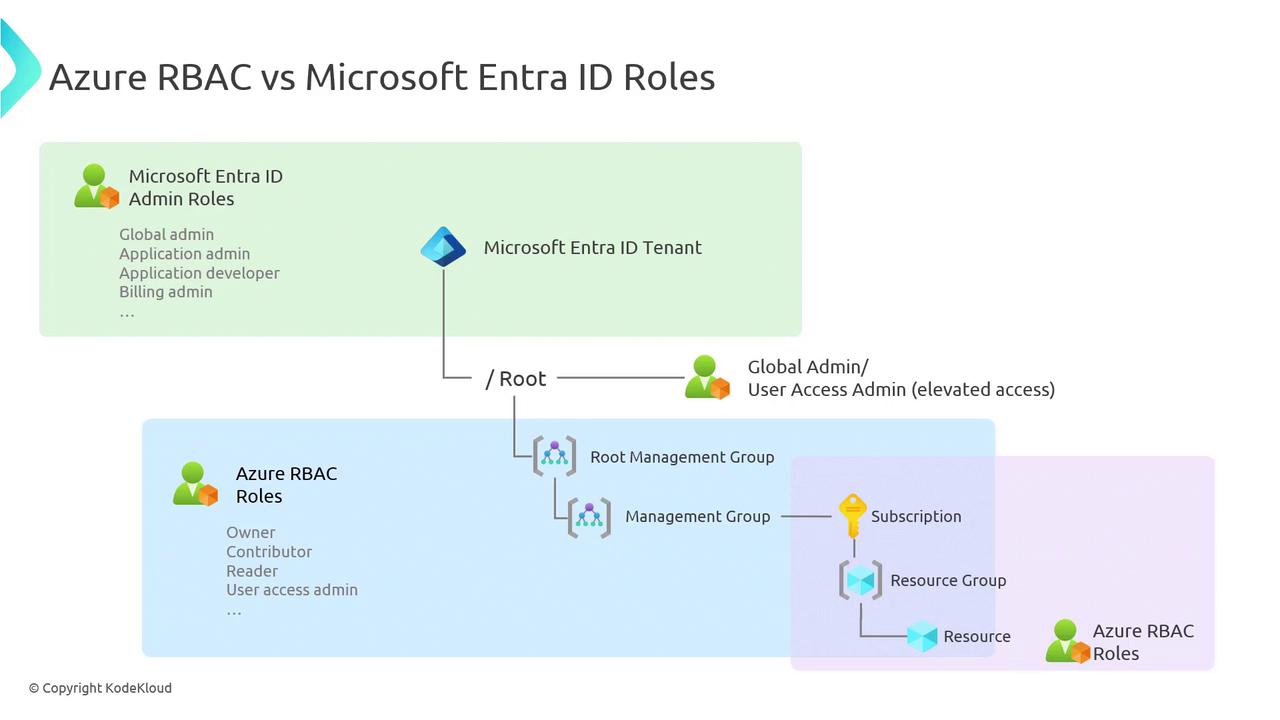[Updated] AZ-104: Microsoft Azure Administrator
Administer Governance and Compliance
Azure RBAC vs Microsoft Entra ID Roles
In this article, we compare two essential permission management tools in the Azure ecosystem: Azure RBAC and Microsoft Entra ID roles. Understanding the differences between these tools is crucial for efficiently managing access within your Azure environment.
Overview
Access control is a key component of any secure Azure deployment. Both Azure RBAC and Microsoft Entra ID roles play unique roles in this process:
- Azure RBAC is designed to manage access to Azure resources such as virtual machines, databases, resource groups, subscriptions, and management groups.
- Microsoft Entra ID roles (formerly known as Azure AD roles) focus on governing access within Microsoft Entra ID. These roles provide control over features like privileged identity management, users, groups, and service principals.
Using this guide, you will learn about the functionalities, scopes, and best practices associated with each tool to help you determine when and how to implement them.
Scope and Functionality
Azure RBAC
Azure RBAC (Role-Based Access Control) allows you to define permissions precisely across various scopes in your Azure environment. You can assign roles at multiple levels, including:
- Entire subscriptions
- Management groups
- Individual resources, such as virtual machines or storage accounts
This flexibility ensures granular control over resource access.
Microsoft Entra ID Roles
Microsoft Entra ID roles operate exclusively at the tenant level. When you assign a role in Microsoft Entra ID, the permissions apply across the entire tenant. Some common roles include:
- Global Administrator
- Billing Administrator
- Global Reader
These roles are intended to provide broad access and management capabilities for the Microsoft Entra ID environment.
Role Assignment and Management Tools
Azure RBAC Role Assignments
Azure RBAC roles can be assigned using various tools and interfaces:
- Azure Portal
- PowerShell scripting
- Azure CLI
- ARM templates for automated deployments
- REST APIs
These multiple interfaces make it easy to integrate RBAC into your existing workflows.
Microsoft Entra ID Role Management
You can manage Microsoft Entra ID roles through several platforms:
- Azure Portal (via Microsoft Entra ID)
- M365 Admin Portal
- Microsoft Graph API and the optional Graph PowerShell module
Practical Demonstration in the Azure Portal
To assign Microsoft Entra ID roles in the Azure Portal, follow these steps:
- Navigate to Microsoft Entra ID.
- Select Roles and Administrators to view available roles for services like Exchange, Teams, and SharePoint.
- To assign a role:
- Choose Users and select a specific user (for example, Abigail).
- Click on Assigned Roles and then Add Assignment.
- Select the appropriate role from the list. Note that roles may include eligible or expired options, which are managed through Privileged Identity Management.
Note
The steps provided in this demonstration are representative and may vary with updates to the Azure Portal interface.
This demonstration illustrates that while both Azure RBAC and Microsoft Entra ID roles help manage permissions, they are designed for different aspects of access control—resource-level versus tenant-level management.
Hierarchical Structure and Integration
Every Azure subscription is linked to a Microsoft Entra ID tenant, creating a hierarchy that harmonizes these two permission systems:
Microsoft Entra ID Tenant (Root):
All Entra roles reside here (e.g., Global Administrator, Application Administrator, Developer, Billing Administrator). A Global Administrator can enable elevated access across both Microsoft Entra ID features and the associated subscriptions without separate Azure RBAC assignments.Root Management Group:
Governed by Azure RBAC with roles such as Owner, Contributor, or Reader. This level can also include nested management groups.Subscriptions, Resource Groups, and Resources:
These follow Azure RBAC rules. For instance, even if a user is assigned as a Billing Administrator at the tenant level, they may not have direct access to subscription-specific billing information without the corresponding RBAC role at that scope.
This integrated approach ensures that high-level administrative tasks are managed via Microsoft Entra ID roles while detailed resource access is handled by Azure RBAC.

Conclusion
In summary, this article has highlighted the key differences between Azure RBAC and Microsoft Entra ID roles. By distinguishing between tenant-level administration and resource-level control, you can implement a robust permission strategy that secures your entire Azure ecosystem.
We hope this guide has enhanced your understanding of access control in Azure. Happy managing, and see you in the next module!
Watch Video
Watch video content